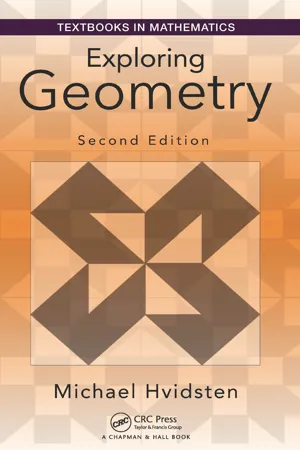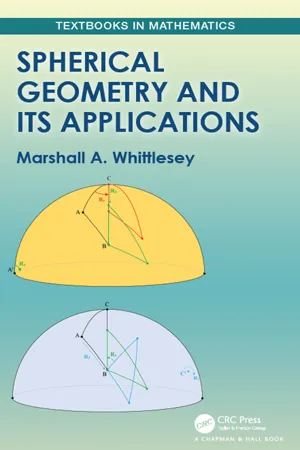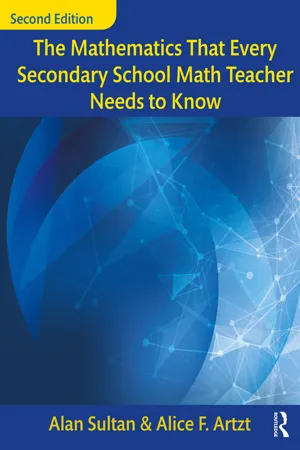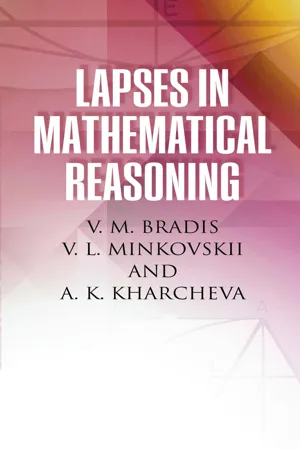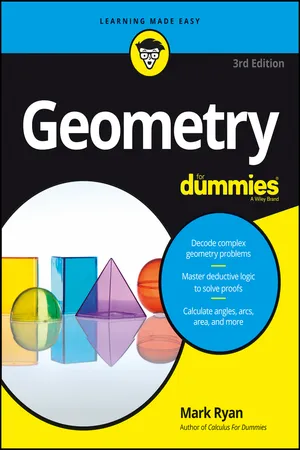Mathematics
SSS and SAS
SSS (Side-Side-Side) and SAS (Side-Angle-Side) are two methods used to prove that two triangles are congruent. SSS states that if the three sides of one triangle are equal to the three sides of another triangle, then the triangles are congruent. SAS states that if two sides and the included angle of one triangle are equal to two sides and the included angle of another triangle, then the triangles are congruent.
Written by Perlego with AI-assistance
Related key terms
6 Key excerpts on "SSS and SAS"
- eBook - ePub
- Michael Hvidsten(Author)
- 2016(Publication Date)
- Chapman and Hall/CRC(Publisher)
ASA: Angle-Side-Angle ,Prop. 26 of Book I) If in two triangles there is a correspondence in which two angles and the included side of one triangle are congruent to two angles and the included side of another triangle, then the triangles are congruent.Theorem 2.12 . (AAS: Angle-Angle-Side ,Prop. 26 of Book I) If in two triangles there is a correspondence in which two angles and the side subtending one of the angles are congruent to two angles and the side subtending the corresponding angle of another triangle, then the triangles are congruent.Theorem 2.13 . (SSS: Side-Side-Side , Prop. 8 of Book I) If in two triangles there is a correspondence in which the three sides of one triangle are congruent to the three sides of the other triangle, then the triangles are congruent .We note here for future reference that the four fundamental triangle congruence results are independent of the parallel postulate; that is, their proofs do not make reference to any result based on the parallel postulate.Let’s see how triangle congruence can be used to analyze isosceles triangles.Definition 2.15 . An isosceles triangle is a triangle that has two sides congruent. The two congruent sides are called the legs of the triangle and the third side is called the base. The base angles of the triangle are those angles sharing the base as a side .Isosceles triangles were a critical tool for many of Euclid’s proofs, and he introduced the next result very early in the Elements . It followed immediately after SAS congruence (Proposition 4).Theorem 2.14 . (Prop. 5 of Book I) In an isosceles triangle, the two base angles are congruent .Proof: Let triangle ΔABC have sidesandA B¯congruent, as shown in Figure 2.9 . LetB C¯be the bisector of ∠ABC , with D inside the triangle. LetB D→intersectB D→at E . Then, by SAS we have triangles ΔABE and ΔCBE congruent and thus ∠EAB ≅ ∠ECBA C¯ - eBook - ePub
- Edward T Walsh(Author)
- 2014(Publication Date)
- Dover Publications(Publisher)
The proof of this lemma is left to the reader. It finds its application in the proofs of our next two theorems.THEOREM 59 The Side-Angle-Side Similarity Theorem (SAS~): Given a one-to-one correspondence between the vertices of two triangles, or a triangle and itself. If two sides of one triangle are proportional to the corresponding sides of the other and the included angles are congruent, then the triangles are similar.Hypothesis: ΔABC; ΔDEF; ∠C ≅ ∠F; andConclusion: ΔABC ~ ΔDPPProof: (an outline): Assuming AC > DF, we introduce such that GC = DP and HC = EF. Then ΔGHC ≅ ΔDEF and ΔABC ~ ΔGHC, which implies that ΔABC ~ ΔDPP.Example 2 Suppose two isosceles triangles have congruent vertex angles, as in the figure. Obviously,Therefore, the SAS~ Theorem applies, and we may write ΔABC ~ ΔDEF.THEOREM 60 The Side-Side-Side Similarity Theorem (SSS~): Given a one-to-one correspondence between the vertices of two triangles, or a triangle and itself. If the corresponding sides are proportional, then the triangles are similar.Hypothesis: ΔABC; ΔDEE withProve: ΔABC ~ ΔDEFProof:The student who does not feel comfortable manipulating expressions that involve square roots (radicals) should review that material in Appendix A.PROBLEM SET 6.4
1. Indicate which of the following figures contain enough information to prove a pair of triangles to be similar. State the similarity relationship and indicate which of AA~, SAS~, and SSS~ you would use to prove it.2. In the figur .(a) If AD = 6 and DC = 4, what is(b) If = 2, what is(c) If AE = 5 and EB = 4 what is(d) If AD = 6, DC = 4 and BC = 9, findDE3. - eBook - ePub
- Marshall Whittlesey(Author)
- 2019(Publication Date)
- Chapman and Hall/CRC(Publisher)
π, and this sum is not generally the same from one triangle to another.However, the angle sum theorem in the plane depends on the parallel postulate, and in fact the SAA congruence theorem in the plane does not depend on the parallel postulate. The reader will find a proof of SAA congruence in the plane in [Mo1963] (or [MD1982]) which makes use of the exterior angle theorem in the plane (which states that an exterior angle of a triangle has measure greater than the measures of either of the opposite interior angles). The spherical analogue of this theorem also turns out to be false.In plane geometry the SSA correspondence does not guarantee congruence of triangles, although we might say that it almost does. Knowledge of the measures of two sides and an angle that is not included leads to the so-called “ambiguous case” in determining the other sides of the triangle. The other sides are uniquely determined if the angle is a right angle, but otherwise there are either two possibilities for the other sides and angles, or the triangle cannot be constructed at all.We can make an immediate observation for spherical geometry: either SSA and SAA both guarantee congruence of triangles or neither does. The reason is that if one guarantees congruence, then we could prove that the other does as well by employing the same argument with polar triangles used in the proofs of ASA and AAA congruence. For example, suppose there were an SAA congruence theorem. To prove that an SSA correspondence guarantees congruence, we would consider two triangles which have an SSA correspondence. Their polar triangles would have an SAA correspondence by Theorem 11.19, and hence would be congruent. The congruence of the pair of polar triangles would in turn guarantee (by Theorem 11.19 again) that the original triangles be congruent. A similar line of reasoning would allow us to use an SSA congruence theorem to prove an SAA congruence theorem. - Alan Sultan, Alice F. Artzt(Authors)
- 2017(Publication Date)
- Routledge(Publisher)
The first result we talk about is something we are all familiar with: If three sides of one triangle have the same lengths as three sides of another triangle, then the triangles are congruent. That is, all their corresponding parts match! This is quite remarkable since we have said nothing about the angles of these triangles. Yet, this follows immediately from the Law of Cosines.Theorem 5.2 (SSS = SSS) If the three sides of triangle ABC are congruent to the three sides of triangle DEF, then the triangles ABC and DEF are congruent .Proof . Let us assume that the sides that match are a and d, b and e , and c and f . (Refer to Figure 5.2 .) So a = d, b = e , and c = f . From equation (5.8) we have thatcos C =a 2+b 2-c 22 a b(5.11) and using the same law in triangle DEF with the corresponding sides, we havecos F =.d 2+e 2-f 22 d e(5.12) Since a = d, b = e , and c = f we can substitute them in equation (5.11) to getcos C =d 2+e 2-f 22 d e(5.13) and we see from equations (5.12) and (5.13) thatcos C = cos F .(5.14) It follows that ∡C = ∡F .In a similar manner using the other versions of the Law of Cosines, equations (5.9) and (5.10) , we can show that ∡A = ∡D and ∡B = ∡E .Thus, if three sides of one triangle are equal to three sides of another triangle, then the corresponding angles match, and so the triangles are congruent.Note: In the proof of Theorem 5.2 (refer to equation (5.14) ), we used the fact that, if cos C = cos F , then ∡C = ∡F . While you may have accepted this, much more is involved in this statement than meets the eye. For now, we will use this fact continually and ask you to accept it. But, we will examine the reason behind it in a later section on technical issues. We now turn to a corollary of our SSS congruence theorem.Corollary 5.3 (HL = HL) Two right triangles are congruent if the hypotenuse and leg of one triangle are congruent to the hypotenuse and leg of the other triangle .Proof . In Figure 5.3 we see two right triangles where the hypotenuse and leg of one have the same lengths as the hypotenuse and leg of the other.We will show the third sides of the triangles have the same length. By the Pythagorean Theorem,Figure 5.3- eBook - ePub
- V. M. Bradis, L. Minkovskii, A. K. Kharcheva(Authors)
- 2016(Publication Date)
- Dover Publications(Publisher)
III. Stories, with Explanations, of Causes of Erroneous Reasoning63. Similar triangles with equal sidesTake two similar scalene triangles and denote the sides of the first in the order of increasing size by the letters a, b, c (a < b < c), and the corresponding sides of the second by the letters a1 , b1 , c1 . By virtue of proportionality of the corresponding sides of similar polygons we have: a1 = aq, b1 = bq, c1 = cq, where q is the coefficient of proportionality, and therefore a1 < b1 < c1 .If q = 1, then all the sides of the two triangles are respectively equal, and the triangles are congruent. The congruence of the triangles is thus a special case of similarity.It may seem, that if the triangles are similar, but not congruent, then they have no equal sides. The erroneousness of such a conclusion is shown by a simple consideration of triangles with the sides 8, 12, 18 cm, and 12, 18, 27 cm. The sides of the second are one-and-one-half times as large as the corresponding sides of the first, and therefore the triangles are similar (but not congruent). As we see, these two triangles have two pairs of respectively equal sides.We shall establish the conditions which have to be satisfied by two similar, but not congruent, triangles having two pairs of respectively equal sides.Suppose that q > 1. The smallest side a of the first triangle (with the sides a, b, c) is less than the smallest side a1 of the second triangle (with sides a1 = aq, b1 = bq, c1 = cq), and cannot be equal to any of the sides of the latter.The middle side b of the first triangle may be equal only to the smallest side a1 of the second triangle (since b is less than b1 = bq and much smaller than c1 = cq), and the greatest side c of the first triangle is equal either to the smallest side a1 or to the middle side b1 of the second triangle. If two sides of the first triangle are equal to two sides of the second triangle, then b = a1 , c = b1 . Hence b = aq, c = bq = aq × q = aq2 . Thus the sides of the first triangle form a geometric progression a, aq, aq2 . The sides of the second triangle are equal to aq, aq2 , aq3 - eBook - ePub
- Mark Ryan(Author)
- 2016(Publication Date)
- For Dummies(Publisher)
Part 3Triangles: Polygons of the Three-Sided Variety
IN THIS PART … Get familiar with triangle basics. Have fun with right triangles. Work on congruent triangle proofs.Passage contains an image Chapter 7
Grasping Triangle Fundamentals
IN THIS CHAPTER Looking at a triangle’s sides: Equal or unequal Uncovering the triangle inequality principle Classifying triangles by their angles Calculating the area of a triangle Finding the four “centers” of a triangleConsidering that it’s the runt of the polygon family, the triangle sure does play a big role in geometry. Triangles are one of the most important components of geometry proofs (you see triangle proofs in Chapter 9 ). They also have a great number of interesting properties that you might not expect from the simplest possible polygon. Maybe Leonardo da Vinci (1452–1519) was on to something when he said, “Simplicity is the ultimate sophistication.”In this chapter, I take you through the triangle basics — their names, sides, angles, and area. I also show you how to find the four “centers” of a triangle.Taking In a Triangle’s Sides
Triangles are classified according to the length of their sides or the measure of their angles. These classifications come in threes, just like the sides and angles themselves. That is, a triangle has three sides, and three terms describe triangles based on their sides; a triangle also has three angles, and three classifications of triangles are based on their angles. I talk about classifications based on angles in the upcoming section “Getting to Know Triangles by Their Angles .”The following are triangle classifications based on sides:- Scalene triangle: A scalene triangle is a triangle with no congruent sides
- Isosceles triangle: An isosceles triangle is a triangle with at least two congruent sides
- Equilateral triangle: A equilateral triangle is a triangle with three congruent sides
Because an equilateral triangle is also isosceles, all triangles are either scalene or isosceles. But when people call a triangle isosceles, they’re usually referring to a triangle with only two equal sides, because if the triangle had three equal sides, they’d call it equilateral.
Index pages curate the most relevant extracts from our library of academic textbooks. They’ve been created using an in-house natural language model (NLM), each adding context and meaning to key research topics.
